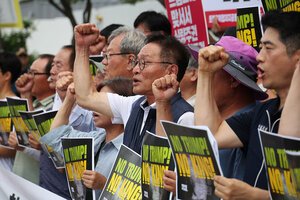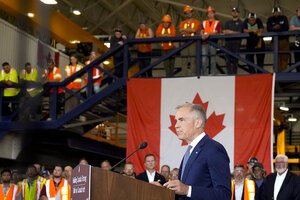President Donald Trump hit his trade deadline with a bang – a slew of orders that add 10% to 50% tariffs on many nations and their goods.
His biggest targets are Canada (35%), Brazil (50%), and goods that a seller has purchased from a third country, such as China, and then sold to the United States as their own (40%).
The cascade of new tariffs, or taxes, on imported goods will likely raise prices for U.S. consumers and businesses alike. So far, those tariffs have not stopped economic growth. But economists expect the new and higher tariffs to accelerate the economy’s current gradual slowdown.
Why We Wrote This
After an era pushing the world toward open trade, the U.S. under President Trump is imposing higher tariffs from Canada to South Korea. His bilateral brinkmanship has won promises of new investment in America, but prices are poised to rise.
After a long era during which the U.S. pushed the world toward more open trade in multilateral talks, Mr. Trump has remade trade policy around his emphasis on bilateral hardball, leveraging America’s economic might as a bargaining tool. He has won promises of big investments in the U.S. from several nations and the European Union. One goal is a boom in American factories.
But greater prosperity for the nation is far from certain.
While many investors are relieved that tariffs seem to be settling at lower levels than President Trump had threatened back in April, uncertainties remain. Negotiations continue with some key trade partners. Additionally, “sectoral” tariffs on specific industries, such as computer chips, may still be forthcoming.
The biggest uncertainty may be legal. A panel of federal appellate court judges on Thursday expressed skepticism that Mr. Trump could impose broad tariffs without congressional approval. Rejection of the administration’s legal rationale for non-sectoral, country-by-country tariffs could blunt much of the president’s broad tariff offensive.

Activists chant slogans during a protest against U.S. President Donald Trump’s tariffs policy near the U.S. embassy in Seoul, South Korea, July 31, 2025.
On Thursday, as his self-imposed Aug. 1 deadline for reaching deals approached, Mr. Trump announced new import levies targeted at various nations that missed the deadline. They include Taiwan (20%), Switzerland (39%), Laos (40%), and Syria (41%). He had already targeted India (25%). But he also signaled some flexibility. Most of the new rates won’t take effect until Aug. 7, giving nations a small window to reach an agreement.
The president also exempted certain raw copper products – such as copper scrap – from his 50% tariff on the imported metal. Most important, he announced a 90-day extension for ongoing talks with Mexico after a phone call with Mexican President Claudia Sheinbaum.
“More and more, we are getting to know and understand each other,” Mr. Trump posted on his Truth Social network.
That extension for Mexico isolates Canada as the only top-five U.S. trading partner without any guarantee of trade or tariff talks after today’s deadline.

Chris Young/The Canadian Press/AP
Canada’s Prime Minister Mark Carney delivers a statement at the Walters Group Steel fabrication plant in Hamilton, Ont., Wednesday, July 16, 2025.
Canadian national pride has soared since President Trump suggested the nation become America’s 51st state. Now, Canadian Prime Minister Mark Carney is finding it difficult to agree to anything that might appear to voters back home to be a concession to Mr. Trump. On Wednesday, Mr. Carney announced Canada would join other nations in recognizing a Palestinian state, a move both Mr. Trump and Israel strongly oppose.
Mr. Trump says he plans to increase Canada’s current 25% tariff rate to 35%. By contrast, the European Union, South Korea, and Japan have struck deals with tariffs at just 15%. For nations where the U.S. sells more goods than it buys, the president is pegging the base tariff rate at 10%.
Canada, like Mexico, is so deeply entrenched in U.S. supply chains of cars and other goods that clamping down on it risks hurting American companies, too. So far, President Trump has allowed Canadian goods to continue to enter the country without heightened tariffs, provided they meet the criteria of the existing United States-Mexico-Canada Agreement. As long as that exemption holds, the overall effect of a tariff hike could be muted.
“I think it will hold,” says Mary Lovely, a senior fellow at the Peterson Institute for International Economics. Too many U.S. companies would scream if it were removed.


